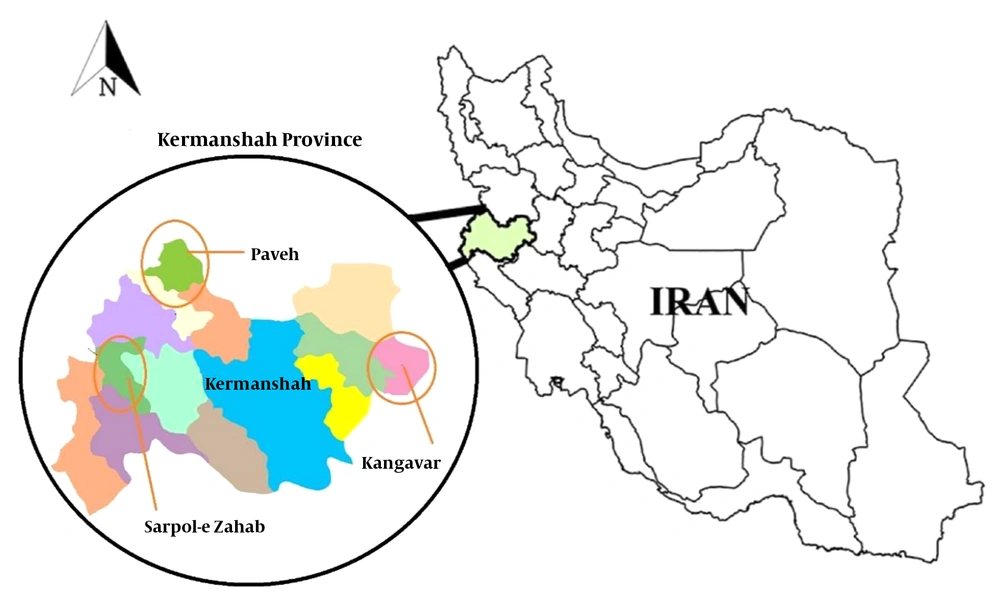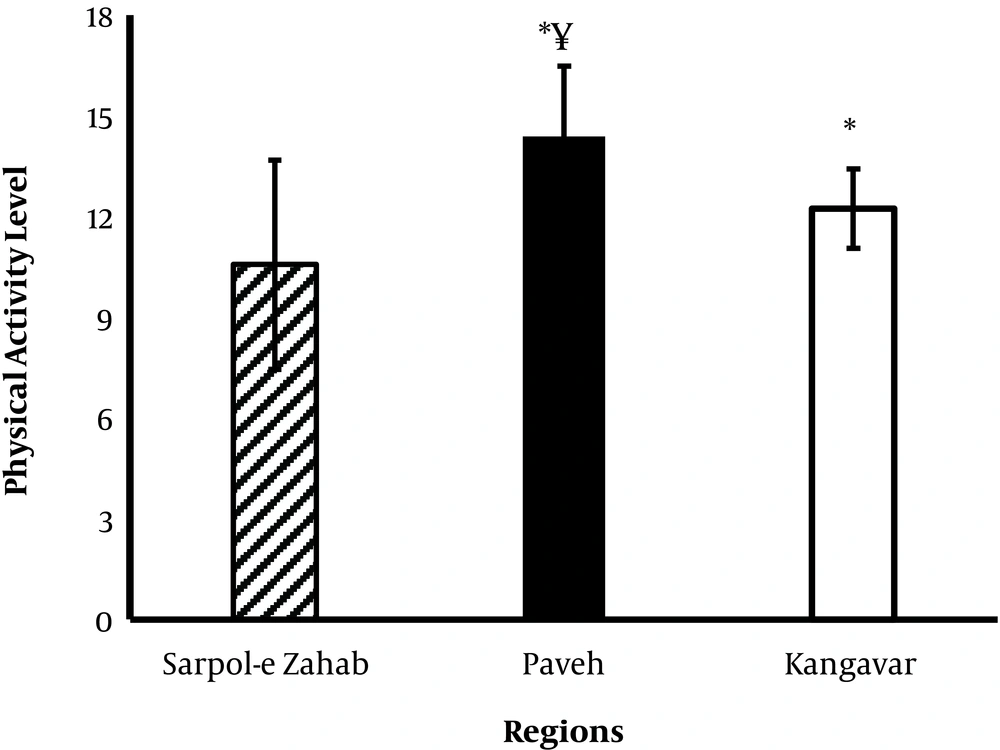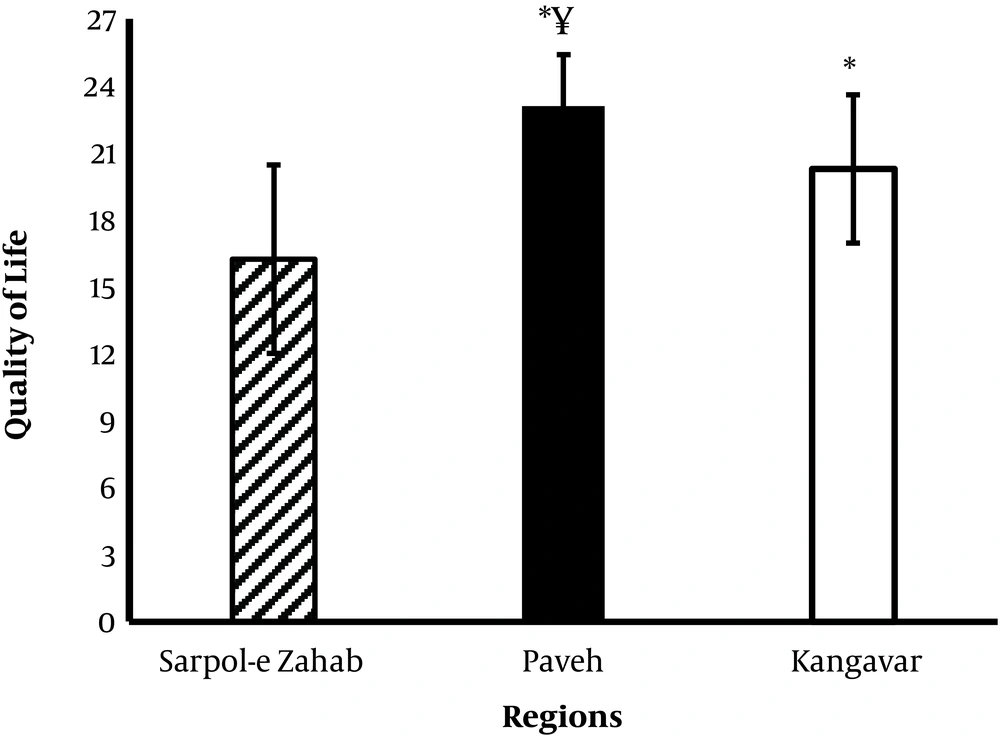1. Background
Aging is described as biological changes along with reduced life expectancy and the individual’s adaptability to sudden changes; Aging is associated with decreased cellular and systemic functions (1, 2). For women, aging is associated with decreased ovaries function and lowers the secretion of its hormones, and these may degrade after menopause, as well (3). Therefore, it can be argued that physiological changes associated with the natural process of aging include changes in body composition in the form of fat-free mass reduction and fat mass accumulation, lack of mobility, reduced physical activity (PA), changes in sex hormones, and steroids, and conditions such as menopause. These factors affect the incidence of insulin function disorders and metabolic syndrome (1, 3). PA is associated with a reduced risk of some health conditions such as coronary heart disease, cancers, diabetes, and stroke (2, 3). Also, PA and mobility are inseparable from human life, manifesting in many various ways in each period (1, 2).
In recent years, as a result of technological advancements and more penetration of industry in the daily lives, the physical activity of both urban settlers and villagers has reduced, providing them with a sedentary lifestyle (3). This poor PA, on the one hand, reduces well-being and happiness, and, on the other hand, increases obesity and related chronic diseases (4, 5). The transition from traditional to modern lifestyles has increased the risk of many chronic diseases such as hypertension, various cancers, mental illness, and diabetes (5). As mentioned by several studies, a sedentary lifestyle is associated with negative changes in anthropometric characteristics (AC), which consequently affects the quality of life (QoL) of individuals (6, 7). Probably the social and cultural backgrounds, as well as individual geographical location, affect the lifestyle, PAL, AC, and ultimately the QoL (7). These changes are more noticeable in women as they enter menopause age.
2. Objectives
The present study intended to examine and compare the PAL, AC, and QOL nomadic women living in the Kermanshah city with different cultural and geographical backgrounds.
3. Methods
3.1. Participants and Study Design
This applied study was conducted from October to November 2019 in Kermanshah, Iran. A multi-stage (Cluster) sampling method was used to select participants. The study population was all middle-aged rural and nomadic women who were living in three cities (Sarpol-e Zahab, Paveh, and Kangavar) of Kermanshah province. It worth noting that these cities are different in terms of cultural and geographical characteristics. The number of rural and nomadic middle-aged women in three cities of Kermanshah province was determined based on the latest inquiry from the National Statistics Center of Iran. Then, according to Morgan's sample size table, a total of 1635 rural and nomadic women living in three cities of Kermanshah province (Sarpol-e Zahab (n = 609); Paveh (n = 480) and Kangavar (n = 546)) were randomly selected (Figure 1); the sample size in each region was estimated based on the papulations. Inclusion criteria were being 40 years of age or older, not using a certain lifestyle due to illness or other factors, not being hospitalized or at home at the time of completing the questionnaire, not having mental disorders (due to affecting answers to questions). The Exclusion criterion was reluctance to participate in the study.
This study was approved by the Ethics Committee of the Islamic Republic of Iran Ministry of sport and youth [Ethics decision no: IR. IMSY.1399.217.20.1950]. All participants filled the written informed consent and agreed to participate as volunteers. Besides, they were informed that they can withdraw from the study at any time.
Data were collected using three questionnaires: assessment of PAL (Baecke) questionnaire, assessment of QoL (SF-12 QoL), and a questionnaire including demographic data and health status (8, 9).
The Baecke is a 16-item questionnaire categorized in three subscales of labor (items 1-8), exercise (items 9 - 12), and leisure time (items 13 - 16) that calculate the PAL. Items are scored on a six-point Likert scale. The total score of PAL is the sum of all items. Therefore, the final PAL score was measured at a rate of 3 - 15. In 1982, Baecke et al. calculated the questionnaire’s reliability as 88%, 81%, 74%, and 81% for the three indices of labor, exercise, and leisure time as well as the total indicators, respectively (9). QoL was assessed using the SF-12. The SF-12 was developed as a shorter alternative to the SF-36 applicable to large-scale health surveys where the application of the longer instrument would be too time-consuming or costly. The SF-12 has 12 questions that are grouped into 8 domains or scales of physical functioning (PF), role limitations due to physical health (RP), bodily pain (BP), general health perception (GH), social functioning (SF), role limitations due to emotional problems (RE), vitality (VT), and mental health (MH). These 8 scales could be reduced into 2 summary components of the physical component summary (PCS) and mental component summary (MCS). The SF 12 was adapted and validated to Persian conditions by Rohani et al. (10). The final score of the SF-12 ranged from 0–100; the higher the score, the better would be the QoL.
3.2. Body Composition and Anthropometric Measurements
Primary measurements, including height (to the nearest 0.1 cm; DLT-411 digital scale made in Germany) and weight (to the nearest 0.1 kg; Sca stadiometer made in Germany) were measured without shoes and in lightweight clothes. BMI was calculated based on a person's weight divided to the squared height (kilograms/m2). Waist circumference was measured with a non-elastic tape to the nearest 0.5 cm (10, 11). Also, a skinfold caliper was used to assess the body fat percentage based on the Jackson-Pollock Formula (12). The measurements were performed at 8 - 9 in the morning, after emptying the bladder. Patients remained in a relaxed seated state for 10 min before measuring the heart rate (HR). To assess the systolic (SBP) and diastolic (DBP) blood pressure, two stable measurements were obtained and an average was recorded (13).
3.3. Data Analysis
The Kolmogorov-Smirnov test was applied to test for a normal distribution. To assess the association between PAL and QOL risk factor, the Pearson correlation test was used. The ANOVA was employed to perform inter-group comparisons, and if significant differences were found, Tukey's post hoc test was used. Data were analyzed using SPSS version 21. Statistical significance was considered when P-value < 0.05.
4. Results
The mean ± SD of BW, BMI, BFP, and WHR were 68.01 ± 14.90, 27.46 ± 5.33, 29.41 ± 9.28, and 0.91 in Sarpol-e Zahab; 67.90 ± 15.56, 27.88 ± 17.85, 33.03 ± 11.97, and 0.93 in Paveh; and 69.24 ± 14.74 28.31 ± 5.59, 30.91 ± 11.67, and 0.92 in Kangavar, respectively. No significant difference was found between the three cities concerning the abovementioned variables (Table 1). The results of ANOVA showed no significant difference between the three regions concerning AC (BW, BMI, BFP, and WHR). While, significant differences were observed concerning physiologic variables (HR, SBP, and DBP) (Table 1).
| Variable | Sarpol-e Zahab (n = 609) | Paveh (n = 480) | Kangavar (n = 546) | P-Value |
|---|---|---|---|---|
| Age (y) | 49.75 ± 14.35 | 48.18 ± 33.84 | 50.10 ± 13.64 | 0.067 |
| BW (kg) | 68.01 ± 14.90 | 67.90 ± 15.56 | 69.24 ± 14.74 | 0.089 |
| Height (cm) | 157.21 ± 6.06 | 157.88 ± 8.41 | 156.30 ± 7.56 | 0.093 |
| BMI (kg/m2) | 27.46 ± 5.33 | 27.88 ± 17.85 | 28.31 ± 5.59 | 0.063 |
| BFP (%) | 29.41 ± 9.28 | 28.03 ± 11.97 | 30.91 ± 11.67 | 0.074 |
| WHR (cm) | 0.91 ± 1.08 | 0.90 ± 1.26 | 0.92 ± 1.28 | 0.061 |
| SBP (mmHg) | 128.36 ± 9.91 | 123.29 ± 2.17c | 124.81 ± 2.17c | 0.031b |
| DBP (mmHg) | 83.22 ± 2.21 | 81.32 ± 2.29c | 81.11 ± 1.05c | 0.045b |
| HR (mmHg) | 81.61 ± 14.87 | 77.17 ± 16.04c | 78.58 ± 11.39c | 0.028b |
Mean ± SD AC Among the Subjects a
Also, the results of the ANOVA test showed a significant difference in PAL between the three cities. In addition, Tukey’s test for post-hoc analysis showed lower PALs in Sarpol-e Zaha compared with Kangavar and Paveh (Figure 2).
Based on the results of the ANOVA test, a significant difference was observed concerning PAL between the three cities. In comparison with Kangavar and Paveh, Tukey’s post-hoc analysis showed a significantly lower QoL in the Sarpol-e Zahab city (Figure 3).
The results of the Pearson correlation test showed a significant positive association between PAL with QoL. However, there was a significant negative association between PAL with anthropometric and physiologic variables (Table 2).
| Variable | PAL | |||||
|---|---|---|---|---|---|---|
| Sarpol-e Zahab | Paveh | Kangavar | ||||
| r | P | r | P | r | P | |
| BMI (kg/m2) | -0.691 | 0.023a | -0.893 | 0.001a | -0.852 | 0.001a |
| BFP (%) | -0.834 | 0.010 a | -0.911 | 0.001a | -0.752 | 0.024a |
| WHR | -0.803 | 0.001a | -0.865 | 0.001a | -0.784 | 0.003a |
| SBP (mmHg) | -0.792 | 0.002a | -0.842 | 0.001a | -0.833 | 0.001a |
| DBP (mmHg) | -0.824 | 0.002a | 0.921 | 0.001a | -0.832 | 0.002a |
| HR (mmHg) | -0.682 | 0.034a | -0.869 | 0.001a | -0.0825 | 0.012a |
| Quality of life | 0.753 | 0.033a | 0.873 | 0.001a | 0.843 | 0.021a |
The Association Between PAL with AC and QOL
5. Discussion
The current study aimed to examine the PAL, AC, and QoL of middle-aged women living in rural and nomadic areas of Kermanshah province (Sarpol-e-Zahab, Paveh, and Kangavar cities).
The findings indicated no significant difference between the three cities concerning AC (BW, BMI, BFP, and WHR). While, physiologic variables (HR, SBP, and DBP) were significantly different between these cities. The physiologic variables were significantly more desirable in Paveh and Kangavar cities compared to the Sarpol-e Zahab city.
According to the findings, it can be argued that living in different areas did not affect the AC of rural and nomadic women. Although the significant increase in physiological variables in the city of Sarpol-e-Zahab was probably due to the occurrence of the earthquake of magnitude 7.3 on 12 November 2017, which had adverse effects on the psychological health of the citizens. The anthropometric and physiological variables of rural and nomadic women were not optimal, which can be attributed to the low PAL. Based on the results of previous studies, inadequate PA can adversely affect the QoL (14, 15). The adverse effects of the earthquake in Sarpol-e Zahab city might be the main reason for the low PAL and QOL compared to other cities. According to the results of these studies, natural disasters and catastrophes have adverse effects on the QoL and general state of a person's life (6, 14). The findings of the present study showed that in all three cities, there was a significant positive association between PAL and QoL. While there were an inverse and significant association between PAL and anthropometric and physiological variables. In other words, this study demonstrated that despite cultural and geographical differences, higher PAL may cause positive changes in QoL and anthropometric and physiological variables. Some studies reported that aging-induced body disorders and disabilities, especially movement restrictions, can increase a person's dependence on others in daily activities, which negatively affects the well-being and, consequently, the QoL (16). According to the literature, increasing PAL in middle-aged persons not only reduces the prevalence of heart disease but also affects the incidence of other physical and psychological disorders and improves the QoL (14, 15). The results of various studies on the effect of PA and exercise on different dimensions of QoL (health, job satisfaction, creativity, social and family relationships) reveal the undeniable role of PA and exercise interventions on physical and mental health as well as social development (17, 18). The positive association between PAL and QoL in the present study can be attributed to the effect of PA on improving anthropometric and physiological variables.
The present study had several limitations, including its cross-sectional nature. Also, some intervening factors such as socio-economic class, education level, and psychological factors have not been considered, which probably has affected the PAL and QoL. Despite these limitations, this is an epidemiological study conducted in a developing society. Previous studies were conducted mostly in industrialized countries, and their findings can be generalized only to similar contexts (i.e., developed countries). The most important strength of this study is the large and appropriate statistical sample and the use of multi-stage cluster sampling.
5.1. Conclusion
Finally, the high prevalence of overweight and obesity, low PAL, and QoL in rural and nomadic women indicate a threatening situation for their health. It can be argued that PA and exercise in middle-aged nomadic and rural women are associated with improved QoL, through improving anthropometric and physiological indicators. Therefore, it is suggested that being physically active in different environments such as families, gyms, etc. should be used as a factor to increase the QoL and life expectancy in middle-aged rural and nomadic women. Also, according to the trend of the population pyramid towards a high number of middle-aged, it is necessary to plan interventions to facilitate the PA in middle-aged women.



